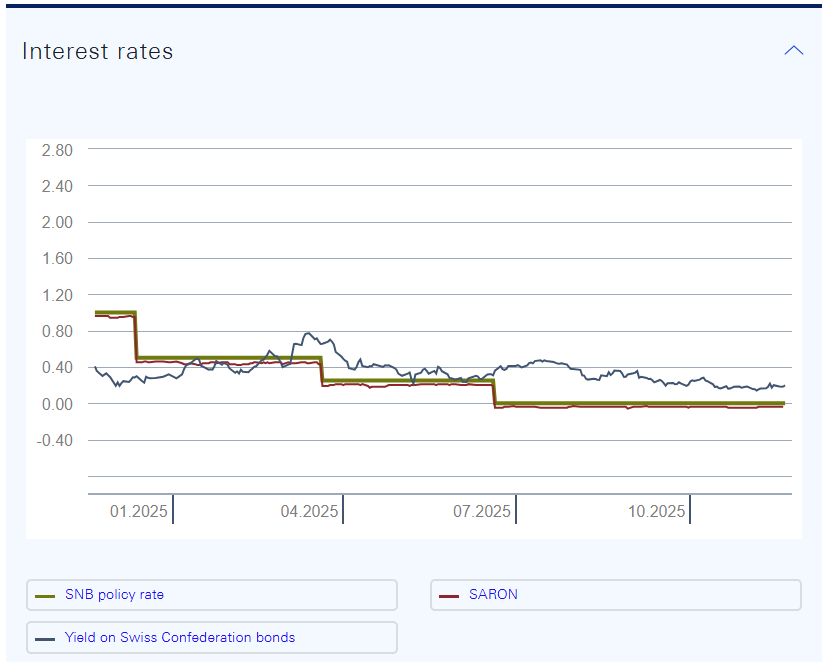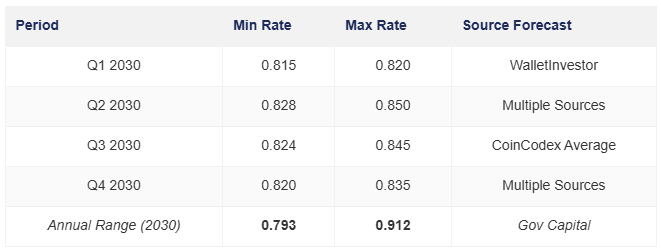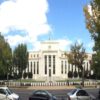- USDCHF remains pressured near multi-year lows, driven by a narrowing US-Swiss yield spread and persistent safe-haven demand for the Swiss Franc.
- SNB is expected to keep rates at 0.00% through 2026, with inflation staying among the lowest globally (0.2% - 0.6%), reinforcing structural CHF strength.
- Technical structure stays bearish.
- Long-term forecasts USDCHF easing further.
Fundamentally, the US-Swiss yield spread continues to be the underlying dynamic for USDCHF. The pair has been driven to multi-year low as the Swiss National Bank remains in an ultra loose-interest rate policy and the Swiss Franc continues to reap safe haven flows. The Federal Reserve’s policy direction and declining US yield advantage have also influenced medium to long-term forecasts.
This USDCHF analysis combines the latest market environment, central bank policy and various institutional investor research, such as reports and positioning data from Reuters, FXStreet, Forex.com, MarketPulse and others — to provide a clear actionable long-term outlook for 2026, 2030 and 2040.
Live Chart of USDCHF
Market Drivers: Why is USDCHF Moving?

The USDCHF moves primarily in response to the monetary policy outlook and yield differential between the Federal Reserve and Swiss National Bank. As of September 2025, economists foresee the SNB keeping its policy rate on hold at 0.00% throughout next year, even though inflation is extremely low — expected to be just 0.2% in 2025 and around 0.6% in 2026, Reuters reported. Under such conditions, the need to raise rates is not urgent, and that is good for the Swiss franc arm.
By contrast, the yield advantage of the US dollar is slowly eroding. FXStreet, in November 2025, for the reported that investors are becoming more convinced that the Fed will cut rates in Washington next year as the labor market slows and inflation eases. Forex.com also noted that “ yield spread compression” in US/Swiss interest rates had undermined potential for upside gains by USDCHF, even the pair struggles to recover from multi-year lows.
Its safe haven factor of the Swiss franc is another mega force of long-term strength. SC.com explained that CHF would still be supported even when data from the Swiss economy is softer (like the GDP drop reported by FXStreet) because global investors still see Switzerland as a place of stability whenever there are geopolitical or financial tensions. Such risk-off inflows persistently cap USDCHF advances when global stress at any given event or the green back fades.
Collectively, they help make the macro environment, very supportive for long-term USDCHF outlook at continues to favor downside.
USDCHF Buy or Sell: Technical Analysis

USDCHF Forecast 2026
It is noted that most of the research convergence on a bearish USDCHF outlook through 2026. ExchangeRates.org projected for the pair to fall back within 0.7750 to 0.7800 by late 2026, highlighting the continued downward force of yield spreads and steady demand for CHF. J2T post its 2025 to 2026 prediction in forecasting USDCHF at 0.8120 by the end of 2025 and yet less thereafter as the dollar loses rate advantage support gains profit.
Reuters’ central bank survey adds to the view that interest rates at 0.00% — with one of the developed world’s lowest inflation profiles — is set in stone for the SNB. This delivers a very stable macroeconomic canvas, in which CHF strength is not cyclical; it is structural. Attention at the same time shifts back to eventual Fed cuts, which dampen USD carry appeal.
Therefore, it can be expected that there is going to be further bearish movements for the pair. While the 0.80000 level is acting as some interim support, medium-term momentum suggests there could soon be further downside. The USDCHF outlook for 2026 sees the trading pair rather settled inside the zone of 0.7750 to 0.7900.
USDCHF Forecast 2030
By 2030, long-term macro cycles drives the USDCHF story. Low inflation, stability in the financial system and conservative attitudes towards money make the CHF appreciate slowly in the long run; one of the main reasons for that is scarcity. There is historical evidence to suggest that during episodes of global deleveraging and risk aversion, the Swiss Franc outperforms.
In the meantime, a number of banks and long-range economics models are indicating there is a gradual break in the US dollar. Analyst from SC.com and Forex.com has written that long-term fiscal deficits, peaking productivity growth and increasing global reserve diversification are all helping to create an entrenched multi-year USD softening bias. Should the Fed pursue a less hawkish demeanor in the late 2020s, it could pull Swiss out of narrower ranges.

Based on these assumptions, the 2030 USDCHF prediction is in line with price projections, placing the pair within or around 0.7400 and 0.7800. This forecast, based on multi-year model reading by J2T and FX long-term forecast aggregators, suggests that the USDCHF will be prone to settle down at its lows, consistent with CHF’s underlying health.
USDCHF Forecast 2040
Predicting into 2040 means we should be looking at structural economic themes, not short term cycles. All of which should see Switzerland’s stable demography, strong banking system, and perpetual low inflation through unscathed. The SNB’s monetary mindset—violate only if you must, as long as possible—also provides ballast to the long-term value of the Swissie.
Meanwhile, international diversification out of the dollar may pick up some steam in the next 20 years. This transition is already occurring by way of greater holdings of non-USD currencies by global central banks and sovereign wealth funds. If these conditions further deteriorate, the USD may keep declining over a longer period, especially against safe haven currencies such as CHF.
Within this context and given a more macro-overview of the current environment, many long-term currency models anticipate USDCHF eventually stabilizing at lower levels. Analyzing the long cycle (synthetic results) generation scenarios from predictions databases and models by institutions, USDCHF will rise towards the 0.7200 to 0.7600 level in 2040.
Frequently Asked Questions
When will USD CHF go up?
If the Federal Reserve becomes more hawkish or if US Treasury yields increase, USDCHF will go up. FXStreet has been constantly mentioning over the past few months how proof of a larger US jobs or demand shock will bring short-covering USDCHF rebounds. Furthermore, in a risk-on mood, less demand for CHF will pump the pair higher. Ongoing upside is so far underpinned by a widening USDCHF yield spread.
Why is USDCHF falling today?
Price drops typically happen on days with weaker US economy data, lower treasury yields, and increased uncertainty in global market. MarketPulse comments on inflows into the safe haven currency, which usually increase during geopolitical tensions, and this weigh directly on USDCHF. Rising hopes on the Fed rate cuts — this via Reuters and others: Intraday or a multi day sell-offs are not helped when such reports break.
Is USD CHF a good buy or sell right now?
Favorable technical indications, such as those from FXLeaders and MarketPulse, also indicate that USDCHF is currently below its long-term downward channel. It is the upside trend to prefer for sell as as long as its macroeconomic fundamentals are in favor of the CHF. To the upside, a bullish reversal with the brake and hold above the 0.8200 resistance zone accompanied by strong momentum.
What factors influence the USDCHF exchange rate?
SNB and Federal Reserve interest rate policy, inflation trends, interest rate differentials, the balance of payments and broad base investment flows are some of the key factors that influence the movement of the pair. Reuters’ central bank surveys, FXStreet’s economic coverage, and Forex.com’s analysis emphasize that yield spreads and geopolitical conditions are the dominant forces shaping medium, and long-term USDCHF trends.




 META
META  ^NDX
^NDX  BTC-USD
BTC-USD  XRP-USD
XRP-USD  SUZLON.NS
SUZLON.NS  CAD=X
CAD=X